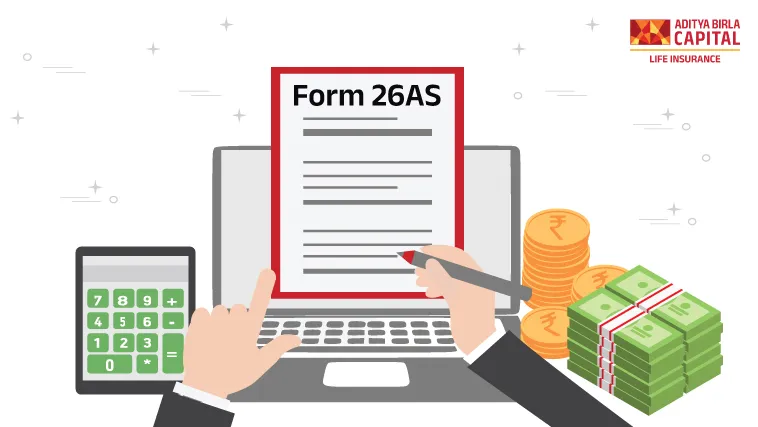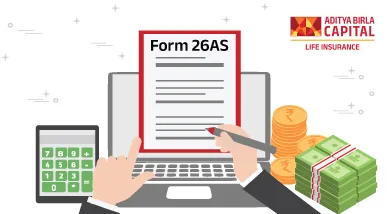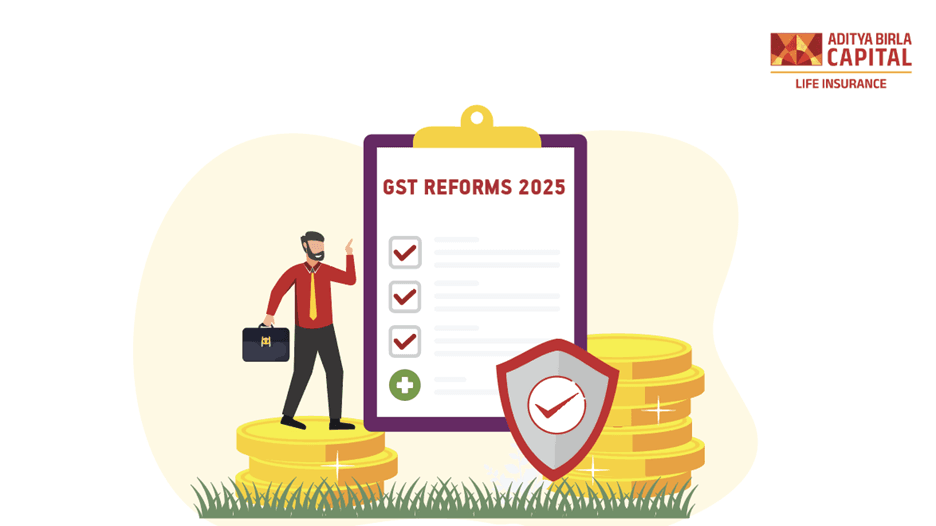Aditya Birla Sun Life Insurance Company Limited

Plan Smarter, Live Better!

Thank you for your details. We will reach out to you shortly.

Currently we are facing some issue. Please try after sometime.


- Table of Contents
Imagine a consolidated statement summarising all your tax-related information for a specific year. That's the essence of Form 26AS! Issued by the Income Tax Department, it is a crucial tool for taxpayers, offering transparency and simplifying tax filing. In this guide, we'll unveil what Form 26AS is, how to view and download it online, and its significance in your tax journey.
What is Form 26AS?
Think of Form 26AS as a one-stop shop for understanding your tax credit picture. It provides details on
-
Tax Deducted at Source (TDS): The tax deducted by various parties like your employer, bank, or mutual fund from your income.
-
Tax Collected at Source (TCS): Tax collected at the source of certain transactions like rent payments or high-value purchases.
-
Advance Tax and Self-Assessment Tax: Taxes you paid directly to the government before filing your return.
-
Refunds: Any tax refunds you receive from the government.
By offering a comprehensive overview of your tax credits, Form 26AS empowers you to:
-
Verify: Ensure the completeness and accuracy of tax deducted at source on your income.
-
Reconcile: Compare the information on Form 26AS with your income tax return to avoid discrepancies.
-
Plan: Use the information to estimate your tax liability and plan your tax payments efficiently.
Information Available on Form 26AS
Form 26AS is a treasure trove of your tax information, containing various crucial details. Here's a table summarising the key categories:
| Category | Information Provided |
|---|---|
| Tax Deducted at Source (TDS) | Details of TDS deducted by various parties, including:
|
| Tax Collected at Source (TCS) | Details of TCS collected at source, including:
|
| Advance Tax and Self-Assessment Tax | Details of taxes paid directly to the government, including:
|
| Refunds | Details of any tax refunds received, including:
|
Remember: This table provides a general overview. Specific details and categories may vary depending on your tax situation.
Structure and Parts of Form 26AS
Understanding the structure of Form 26AS can further enhance its usability. Here's a breakdown of its key sections:
| Part | Description |
|---|---|
| Part A : Demography | Contains basic information like PAN, name, address, and assessment year. |
| Part B : Tax Deducted at Source (TDS) | Details TDS deducted under various heads like salary, interest, rent, etc. |
| Part C : Tax Collected at Source (TCS) | Provides details of TCS collected on transactions like rent payments, high-value purchases, etc. |
| Part D : Advance Tax and Self-Assessment Tax | Lists any advance tax or self-assessment tax payments made directly to the government. |
| Part E : Refunds | Shows tax refunds received from the government during the year. |
| Part F : High-Value Transactions | Details high-value transactions exceeding specified limits, including foreign remittances, mutual fund purchases, and immovable property transactions. |
| Part G : Tax Payments (For Specified Assessees) | Applicable to specific categories of taxpayers and displays additional tax payments made. |
By familiarising yourself with these sections, you can easily navigate Form 26AS and extract the information relevant to your tax filing needs.
Accessing Your Tax Data: Viewing and Downloading Form 26AS Online
Now that you understand the wealth of information within Form 26AS, let's explore how to conveniently access and download it online! Both the Income Tax Department website and your net banking platform offer easy options:
Viewing and Downloading from the Income Tax Department Website:
Step 1: Visit the e-filing portal: Head to https://incometaxindia.gov.in/ and click on "e-File" in the main menu.
Step 2: Login: Use your PAN and password to log in to your e-filing account.
Step 3: Navigate to Form 26AS: In the "e-File" menu, select "Income Tax Returns" and then choose "View Form 26AS". (Read the disclaimer, click 'Confirm' and you will be redirected to TDS-CPC Portal)
Step 4: Select Assessment Year: On the TDS-CPC Portal, Choose the relevant assessment year (financial year) for which you want to view the form.
Step 5: View or Download: You can view the form online or download it in PDF format for offline reference.
Viewing and Downloading from Your Net Banking Platform:
Step 1: Log in to your Net Banking: Access your online banking platform using your credentials.
Step 2: Locate Tax Services: Look for a section dedicated to "Tax Services" or "Tax Information".
Step 3: View Form 26AS: Select the option to view your Form 26AS. This feature might be available under specific accounts or require contacting your bank for activation.
Step 4: Download or Print: Download the form as a PDF or print it directly for your records.
Remember:
-
Both methods are secure and reliable for accessing your Form 26AS. Choose the option that best suits your convenience.
-
Ensure you have a stable internet connection for online viewing and downloading.
Leveraging Form 26AS for Tax Planning and Compliance: A Powerful Tool
Form 26AS goes beyond mere data compilation. Here's how you can utilise it for informed tax planning and compliance:
-
Reconcile Tax Deductions: Compare the TDS details on Form 26AS with your Form 16s or investment statements to ensure all deductions are reflected accurately.
-
Identify Discrepancies: If you find any discrepancies, report them to the concerned deductor or the Income Tax Department for timely rectification.
-
Estimate Tax Liability: Use the information on TDS, advance tax payments, and refunds to estimate your final tax liability and plan any remaining tax payments strategically.
-
Support Tax Return Filing: Utilise Form 26AS as a reference while filing your tax return to ensure completeness and accuracy.
-
Claim Additional Exemptions: Review the high-value transaction details to identify eligible deductions or exemptions you might have missed.
By actively using Form 26AS, you can streamline your tax filing process, minimise potential errors, and make informed decisions for better tax management.
Pro tip: Consulting a tax advisor can provide personalised guidance based on your specific tax situation and ensure optimal utilisation of Form 26AS for your financial benefit.
What's New in Form 26AS?
Form 26AS undergoes periodic updates to reflect any changes in tax regulations or reporting requirements. While the core information it provides remains the same, here are some recent updates to be aware of:
-
More Personal Details: The new form includes additional personal details like date of birth, registered email address, and mobile number. This aims to improve communication and enable easier updates to your information.
-
Expanded Tax and Proceedings Details: Apart from TDS/TCS and tax payments, the form now reflects advance tax or self-assessment tax paid by you. It also shows details of outstanding tax demands and completed/pending assessment proceedings. This provides a more holistic view of your tax status.
-
Foreign Remittance Reporting: High-value foreign remittances (above Rs. 5 lakh) are now reported in Form 26AS, enhancing transparency and compliance monitoring.
-
Financial Transaction Reporting: Details of specific financial transactions like mutual fund purchases, dividend income, and immovable property deals exceeding specified limits are now included, aiding in identifying potential tax liabilities.
Why is Form 26AS Important?
Form 26AS transcends being just a data repository. Here's why it holds significant importance for taxpayers:
-
Transparency and Accuracy: It offers a consolidated view of your tax credits, ensuring transparency and minimising discrepancies in TDS reporting.
-
Reconciliation and Error Detection: You can easily compare the information with other tax documents like Form 16s to identify and rectify any errors in tax deductions or payments.
-
Informed Tax Planning and Filing: Utilising Form 26AS empowers you to estimate your tax liability accurately, plan any remaining payments strategically, and file your tax return with confidence.
-
Reduced Scrutiny and Penalties: Timely reconciliation and rectification of discrepancies using Form 26AS help minimise chances of tax department scrutiny and potential penalties.
-
Supporting Refund Claims: If you have overpaid taxes, the details in Form 26AS can support your claim for a refund.
-
Improved Compliance and Peace of Mind: By actively using Form 26AS, you can foster a more responsible and proactive approach to tax compliance, leading to greater peace of mind.
Things to Verify in TDS Certificates with Form 26AS
It's crucial to compare your TDS certificates (like Form 16, 18, etc.) with Form 26AS to ensure all deductions are reflected accurately. Here's what to check:
-
PAN and Assessment Year: Verify that the PAN and assessment year (financial year) match on both documents.
-
Deductor Information: Ensure the deductor's name, PAN, and TAN (Tax Deduction and Collection Account Number) are identical in both documents.
-
Amount Deducted: Match the tax-deducted amount mentioned in your TDS certificate with the corresponding entry in Form 26AS.
-
Date of Deduction: Confirm that the date of tax deduction on the certificate aligns with the date reflected in Form 26AS.
-
Section under which TDS Deducted: Verify that the section under which the tax was deducted is the same in both documents.
-
High-Value Transactions: If applicable, compare details of high-value transactions like rent payments or immovable property deals in Form 26AS with your records.
Additional Tips:
-
Download all your TDS certificates from the TRACES website for a comprehensive comparison.
-
If you find any discrepancies, report them immediately to the deductor or the Income Tax Department for rectification.
-
Consider consulting a tax advisor for personalised guidance, especially if you have complex tax situations.
By understanding the importance of Form 26AS and actively comparing it with your TDS certificates, you can ensure accurate tax reporting, minimise errors, and ultimately navigate your tax journey with confidence and peace of mind.
What if there is any mismatch in details with Form 26AS?
Finding discrepancies between your TDS certificates and Form 26AS can be concerning, but don't panic! Here's what you should do:
-
Identify the Mismatch: Carefully compare the details, like PAN, assessment year, deductor information, the amount deducted, and the date of deduction. Pinpoint specific mismatches.
-
Gather Supporting Documents: Collect relevant documents like your TDS certificates, investment statements, and proof of tax payments.
-
Contact the Deductor: The first step is to reach out to the entity responsible for deducting the tax (employer, bank, mutual fund, etc.). Inform them about the mismatch and provide supporting documents.
-
File a Rectification Request: If the deductor acknowledges the error, they can file a revised TDS return to rectify the mistake. You might receive a revised Form 16 or 18 reflecting the correction.
-
Report to the Income Tax Department: If the deductor is unresponsive or denies the error, you can report the discrepancy to the Income Tax Department through the online Tax Grievance Redressal Mechanism ([[invalid URL removed]]). Provide details and attach supporting documents.
-
Respond to Department Notices: If the department identifies a mismatch during processing, you might receive a notice. Respond promptly with explanations and necessary documents.
Remember: Timely action is crucial to avoid potential penalties or delays in refunds. If unsure, consult a tax advisor for personalised guidance.
What Distinguishes Forms 16 and 16A from Form 26AS?
| Feature | Form 16/16A | Form 26AS |
|---|---|---|
| Purpose | Provides details of TDS deducted by a specific deductor (employer, bank, etc.) for the year. | Offers a consolidated view of all tax credits (TDS, TCS, tax payments, refunds) for the year. |
| Issued By | Deductor | Income Tax Department |
| Information Scope | Limited to TDS deducted by a particular entity. | Comprehensive; includes TDS, TCS, advance tax, refunds, high-value transactions, etc. |
| Availability | Received from the deductor. | Downloaded from the e-filing portal or net banking. |
| Focus | Specific tax deductions by one entity. | Overall tax picture and compliance. |
| Rectification | Requires contacting the specific deductor. | This may involve contacting the deductor or Income Tax Department depending on the mismatch. |
Remember: Both Forms 16/16A and Form 26AS play crucial roles in tax filing. Utilise them effectively for accurate reporting and informed tax management.
Introduction of Annual Information Statement (AIS)
While Form 26AS offers valuable insights, the Income Tax Department recently introduced (provide financial year details) the Annual Information Statement (AIS), which expands on and supersedes Form 26AS in some ways. Here's a breakdown:
- Similarities:Both AIS and Form 26AS provide consolidated tax information for a specific year.They include details like TDS/TCS, tax payments, and refunds.
- Differences: AIS offers a more comprehensive view, including:
- Additional Income Details: Interest income on savings accounts, dividend income, capital gains, rental income, etc.
- Financial Transactions: Details of high-value transactions like immovable property deals, foreign remittances, and mutual fund purchases.
- Feedback Mechanism: Taxpayers can review and provide feedback on AIS information, potentially leading to quicker error correction.
Conclusion
Understanding both Form 26AS and AIS empowers you to leverage these valuable tools for informed tax decisions. Remember:
-
Form 26AS: Access and compare details with your TDS certificates to ensure accuracy.
-
AIS: Utilise its broader scope for comprehensive tax planning and potential error correction through feedback.
By actively engaging with these resources, you can navigate your tax journey with greater confidence and clarity.
Additional Points:
-
Consider consulting a tax advisor for personalised guidance, especially if you have complex tax situations.
-
Stay updated on any further changes or developments related to Form 26AS and AIS.
Thank you for your details. We will reach out to you shortly.
Thanks for reaching out. Currently we are facing some issue.
Buy ₹1 Crore Term Insurance at Just ₹575/month1
ABSLI DigiShield Plan
Life cover up to 100 years of age.
Joint Cover Option
Inbuilt Terminal Illness Benefit
Tax Benefit^
Return of Premium Option~
Life Cover
₹1 crore
Premium:
₹575/month1
Most Popular Calculator
Guaranteed returns after a month¹
ADV/6/24-25/646







